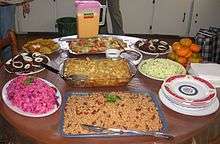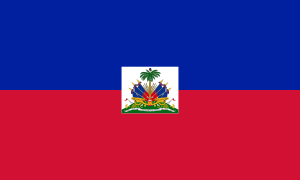Haitians
Haitians (French: Haïtiens, Haitian Creole: Ayisyen) are the citizens of Haiti and the descendants in the diaspora through direct parentage. An ethno-national group, Haitians generally comprise the modern descendants of self-liberated Africans in the Caribbean territory historically referred to as Saint-Domingue. This includes the mulatto minority who denote corresponding European ancestry, notably from French settlers.[35] By virtue of historical distinction, the vast majority of Haitians share and identify with this common African lineage, though a small number are descendants of contemporary immigrants from the Levant who sought refuge in the island nation during World War I and World War II.[18][36]
Definitions
According to the Constitution of Haiti, a Haitian citizen is:
- Anyone, regardless of where they are born, is considered Haitian if either their mother or father is a native-born citizen of Haiti. A person born in Haiti could automatically receive citizenship.
- A foreigner living in Haiti who has had a continuous period of Haitian residence for five years can apply for citizenship and will have the right to vote, but is not eligible to hold public office until five years after their date of naturalization, excluding those offices reserved for native-born Haitians by Constitutional law.
Dual citizenship
The Haitian Constitution of 2012 re-legalizes dual citizenship, allowing for Haitians living abroad to own land and run for Haitian political office (except for offices of president, prime minister, senator or member of the lower house of Parliament).
Ethnic groups
Haiti's population is mostly of African descent (5% are of mixed African and other ancestry),[37] though people of many different ethnic and national backgrounds have settled and impacted the country, such as Poles[38][39] (Polish legion), Jews,[38][40] Arabs[41] (from the Arab diaspora), Chinese,[42] Indians,[43][44] Spanish, Germans[45][46] (18th century and World War I), Italians,[41] and French, most marrying into the majority black populace and in turn yielding mixed race children (many of whom are prominent in Haitian society).
Languages
The official languages of Haiti are French and Haitian Creole.
Traditionally, the two languages served different functions, with Haitian Creole the informal everyday language of all the people, regardless of social class, and French the language of formal situations: schools, newspapers, the law and the courts, and official documents and decrees. However, because the vast majority of Haitians speak only Creole, there have been efforts in recent years to expand its use. In 1979, a law was passed that permitted Creole to be the language of instruction, and the Constitution of 1983 gave Creole the status of a national language. However, it was only in 1987 that the Constitution granted official status to Creole.
Culture
Art
Haitian art, known for its vibrant color work and expressive design, is a complex tradition, reflecting strong African roots with Indigenous American and European aesthetic and religious influences. It is a very important representation of Haitian culture and history. Haitian art is distinctive, particularly in painting and sculpture where brilliant colors, naive perspective and sly humor characterize it. Frequent subjects in Haitian art include big, delectable foods, lush landscapes, market activities, jungle animals, rituals, dances, and gods. Artists frequently paint in fables.
Music and dance
The music of Haiti combines a wide range of influences drawn from the many people who have settled on this Caribbean island. It reflects French, African rhythms, Spanish elements and others who have inhabited the island of Hispaniola and minor native Taino influences. Youth attend parties at nightclubs called discos, (pronounced "deece-ko"), and attend Bal. This term is the French word for ball, as in a formal dance. Styles of music unique to the nation of Haiti include music derived from Vodou ceremonial traditions and Méringue, Rara parading music, Twoubadou ballads, Mini-jazz rock bands, Rasin movement, Hip hop Kreyòl,[47] and Compas. Compas, short for compas direct, is a complex, ever-changing music that arose from African rhythms and European ballroom dancing, mixed with Haiti's bourgeois culture. It is a refined music, with méringue as its basic rhythm. In Creole, it is spelled as konpa dirèk or simply konpa, however it is commonly spelled as it is pronounced as kompa.[48]
Until 1937, Haiti had no recorded music, until Jazz Guignard was recorded non-commercially. One of the most celebrated Haitian artists today is Wyclef Jean. Wyclef Jean, however, left the country before his teenage years and began the Fugees with Lauryn Hill and Pras, who together went on to become the biggest selling hip hop group of all time with The Score released in 1996.
Cuisine

Haitian cuisine originates from several culinary styles from the various historical ethnic groups that populated the western portion of the island of Hispaniola. Haitian cuisine is similar to the rest of the Latin-Caribbean (the French and the Spanish-speaking countries of the Antilles), however it differs in several ways from its regional counterparts. While the cuisine is unpretentious and simple, the flavors are bold and spicy that demonstrate a primary influence of African culinary aesthetic, paired with a very French sophistication.
Religion
Haiti is similar to the rest of Latin America, in that it is a predominantly Christian country, with 80% Roman Catholic and approximately 16% professing Protestantism. A small population of Muslims and Hindus exist in the country, principally in the capital of Port-au-Prince.
Vodou, encompassing several different traditions, consists of a mix of Central and Western African, European, and Native American (Taíno) religions, is also widely practiced, despite the negative stigma that it carries both in and out of the country. The exact number of Vodou practitioners is unknown; however, it is believed that a small proportion of the population practice it, often alongside their Christian faith. Some secular Christians also have been known to participate in some rituals, although indirectly.
Migration
In 1998, a World Bank estimation claimed that approximately 800,000 Haitian citizens were residents of Dominican Republic. By 2001, approximately 15,000 Haitians had migrated to Dominican Republic to work in sugar mills.[49] Haitians workers also migrated to other countries such as the United States, France, Canada, the Bahamas and other Caribbean Islands. In 2006, Approximately 800,000 Haitians resided in the United States (especially in the Miami and New York City areas), 60,000 Haitians were living in France (especially Paris) 40,000 in Canada (especially Montreal) while 80,000 were dispersed between the Bahamas and other Caribbean Islands.[49]The Haitian migration has greatly hindered the development of Haiti in comparison to other countries. Some of the country's most skilled individuals have migrated elsewhere; an estimated 70 percent of Haiti’s skilled human resources have left Haiti. In the 2010 U.S. Census, 907,790 citizens identified as Haitian immigrants or with their primary ancestry being Haitian. An increase of just over 100,000 Haitians from 2006. The confiscation of property, massacres, and prosecution caused the upper and middle class of Haiti to migrate to more developed countries in Europe and the United States.[50]
Haitians
See also
References
- Haiti & The Dominican Republic IMF population estimates
- Bureau, U. S. Census. "American FactFinder - Results". factfinder.census.gov. Archived from the original on 2020-02-12. Retrieved 2019-09-24.
- "Total ancestry categories tallied for people with one or more ancestry categories reported 2010 American Community Survey 1-Year Estimates". United States Census Bureau. Archived from the original on 18 January 2015. Retrieved 30 November 2012.
- Pina, Diógenes. "DOMINICAN REPUBLIC: Deport Thy (Darker-Skinned) Neighbour". Inter Press Service (IPS). Archived from the original on March 12, 2008. Retrieved 2008-10-14.
- Haiti in Cuba Retrieved 2013-12-30.
- Press, ed. (2020). "Estimación de personas extranjeras residentes habituales en Chile al 31 de diciembre 2019" (PDF) (in Spanish). Instituto Nacional de Estadísticas (INE). p. 21. Retrieved 30 June 2020.
- Godoy, Gloria, ed. (12 May 2020). "Según estimaciones, la cantidad de personas extranjeras residentes habituales en Chile bordea los 1,5 millones al 31 de diciembre de 2019" (in Spanish). Instituto Nacional de Estadísticas (INE). Retrieved 30 June 2020.
- Statistics Canada. "Census Profile, 2016 Census (Canada [Country])". Retrieved 28 July 2019.
- https://web.archive.org/web/20140428173752/http://www.insee.fr/fr/ppp/bases-de-donnees/donnees-detaillees/pop-immigree-pop-etrangere-2008/Tableau-immigres-CDMF2-France-RP2008.xls Institut national de la statistique et des études économiques (INSEE, 2008)
- "Haitian Creole", Ethnologue.com Website, accessed 4 May 2011
- Bahamas outlook clouds for Haitians by Nick Davis, BBC News, 20 September 2009. Retrieved 2010-02-16.
- Press, ed. (19 December 2016). "Haitianos são os principais imigrantes no Brasil". Folha Do Estado. Retrieved 3 August 2020.
- "Do Haiti para o Brasil. Com uma escala no Equador" [From Haiti to Brazil, with a stop in Ecuador]. El País (in Portuguese). 16 March 2015. Retrieved 22 May 2015.
- "French Guiana - Atlapedia® Online". www.atlapedia.com.
- "Celebrating 50 years of the Haitian diaspora in Guyana". Le Nouvelliste.
- "Ice cream sales a lifeline for Haitians in Caracas". March 22, 2010 – via www.reuters.com.
- "French Guiana, Guadeloupe, and Martinique". Archived from the original on 2013-05-24.
- "People Groups: Haiti". Joshua Project. Retrieved 13 October 2014.
- Carrie Kahn (February 7, 2017). "Haitians Denied Entry Into The U.S. May Have To Start New Lives In Mexico". Morning Edition. NPR.
- "Haïtianen: blij in Suriname - Parbode Magazine". Archived from the original on 2016-02-01. Retrieved 2014-12-22.
- Cadet, Ruth, ed. (4 April 2018). "La communauté haïtienne en Suisse veut s'engager dans le développement du pays". Le Nouvelliste. Retrieved 1 August 2020.
- "Diaspora wants a say in Haiti's future". Retrieved 13 February 2014.
- 2010 Census U.S. Virgin Islands: Place of Birth
- {cite web|url=https://www.lalibre.be/international/reunion-de-famille-pour-les-haitiens-de-belgique-51b8b560e4b0de6db9b9b205%7Ctitle=Réunion "de famille" pour les Haïtiens de Belgique|first=La|last=Libre.be|date=January 16, 2010|website=www.lalibre.be}}
- "Quake brings UK Haitians together". January 15, 2010 – via news.bbc.co.uk.
- "Haitian Trafficking Victims Discovered in Ecuador | Inter Press Service". www.ipsnews.net.
- Frigerio, Alejandro (January 24, 2010). "AfroAmericanas: Inmigrantes haitianos en Argentina -según La Nacion.com".
- "NRC - Nieuws, achtergronden en onderzoeksjournalistiek". NRC.
- "Haitianos en España. Padrón municipal, cifras de población. EPA.com.es". epa.com.es.
- "Statistiche: haitiani in Italia". Comuni-Italiani.it.
- "Haitiani in Italia - statistiche e distribuzione per regione". Tuttitalia.it.
- Haitianer bangen um ihre Verwandten « DiePresse.com
- Homeland is where the heart is for Haitians
- , Cia.gov Website, accessed 20 March 2020
- "CIA World Factbook – Haiti". Retrieved 3 September 2019.
- "The Virtual Jewish History Tour: Haiti". Jewishvirtuallibrary.org. Retrieved 14 January 2010.
- "Haiti". The World Factbook. Central Intelligence Agency. 12 July 2018. Retrieved 2018-07-12.
- "The Polish Influence in Casale, Haiti and Contribution to the Haitian Revolution". Archived from the original on 25 February 2014. Retrieved 7 February 2014.
- "Polish Haitians: How They Came to Be". Retrieved 6 February 2014.
- "Haiti". Jewish Virtual Library. Retrieved 2014-02-07.
- "From Lebanon to Haiti: A Story Going Back to the 19th Century". Retrieved 30 January 2014.
- "Chinese in Haiti may be evacuated". China Daily. Retrieved 2014-01-04.
- "HugeDomains.com - AyitinOu.com is for sale (Ayitin Ou)". www.hugedomains.com. Archived from the original on May 18, 2013.
- "Indians in Haiti seek monetary help". February 18, 2010 – via www.thehindu.com.
- "Haiti And The German Connection". Retrieved 30 January 2014.
- "Haiti Net Foreign Relations". Retrieved 30 January 2014.
- "Music and the Story of Haiti". Afropop Worldwide. Archived from the original on 13 November 2007. Retrieved 24 July 2013.
- Wise, Brian. "Band's Haitian Fusion Offers Fellow Immigrants a Musical Link to Home". New York Times. Retrieved 24 January 2015.
- Martin, Philip; Midgley, Elizabeth; Teitelbaum, Michael S. (2006-02-23). "Migration and Development: Whither the Dominican Republic and Haiti?". International Migration Review. 36 (2): 570–592. doi:10.1111/j.1747-7379.2002.tb00093.x. ISSN 0197-9183.
- MIGUEL RODRIGUES DE SOUZA, OBERDAN. MODELO DE PDF PRESUMIDA COM CINÉTICA QUÍMICA TABULADA APLICADA PARA A COMBUSTÃO EM SPRAYS (Thesis). Faculdades Catolicas.
Further reading
- Moreau de Saint Mery, Louis (1797–1798). Description topographic, physical, civil, and political history of the French part of the isle Saint-Domingue. Paris.
- Garrigus, John (2006). Before Haiti: Race and Citizenship in French Saint-Domingue. U.S.

.jpg)